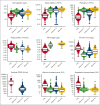Diagnostic guidelines for familial hemophagocytic lymphohistiocytosis revisited
- PMID: 39046779
- PMCID: PMC11619794
- DOI: 10.1182/blood.2024025077
Diagnostic guidelines for familial hemophagocytic lymphohistiocytosis revisited
Abstract
Current hemophagocytic lymphohistiocytosis 2004 (HLH-2004)-based diagnostic criteria for familial hemophagocytic lymphohistiocytosis (FHL) are based on expert opinion. Here, we performed a case-control study to test and possibly improve these criteria. We also developed 2 complementary expert opinion-based diagnostic strategies for FHL in patients with signs/symptoms suggestive of HLH, based on genetic and cellular cytotoxicity assays. The cases (N = 366) were children aged <16 years with verified familial and/or genetic FHL (n = 341) or Griscelli syndrome type 2 (n = 25); 276 from the HLH-94/HLH-2004 databases and 90 from the Italian HLH Registry. All fulfilled the HLH-94/HLH-2004 patient inclusion criteria. Controls were 374 children with systemic-onset juvenile idiopathic arthritis (sJIA) and 329 + 361 children in 2 cohorts with febrile infections that could be confused with HLH and sepsis, respectively. To provide complete data sets, multiple imputations were performed. The optimal model, based on 17 variables studied, revealed almost similar diagnostic thresholds as the existing criteria, with accuracy 99.1% (sensitivity 97.1%; specificity 99.5%); the original HLH-2004 criteria had accuracy 97.4% (sensitivity 99.0%; specificity 97.1%). Because cellular cytotoxicity assays here constitute a separate diagnostic strategy, HLH-2004 criteria without natural killer (NK)-cell function was also studied, which showed accuracy 99.0% (sensitivity, 96.2%; specificity, 99.5%). Thus, we conclude that the HLH-2004 criteria (without NK-cell function) have significant validity in their current form when tested against severe infections or sJIA. It is important to exclude underlying malignancies and atypical infections. In addition, complementary cellular and genetic diagnostic guidelines can facilitate necessary confirmation of clinical diagnosis.
© 2024 American Society of Hematology. Published by Elsevier Inc. Licensed under Creative Commons Attribution-NonCommercial-NoDerivatives 4.0 International (CC BY-NC-ND 4.0), permitting only noncommercial, nonderivative use with attribution. All other rights reserved.
Conflict of interest statement
Conflict-of-interest disclosure: J.-I.H., E.S., A.R.K., and K.L. serve as consultants and/or on advisory boards for Sobi. M.B.J. serves as consultant and/or on advisory board for, and has received research support from, Sobi. R.Q.C. serves as a consultant for Sobi, Pfizer, AbbVie, Curbside Consultations, Vindico Medical Education, and Lilly; serves on an advisory board for Sobi; and serves as an unpaid consultant for Apollo Therapeutics. A.H. serves as a consultant for Sobi and a speaker for Novartis. A.N. is on the advisory board for Jazz Pharmaceuticals. S.W.C. has received consulting fees from Apollo and Simcha Therapeutics and speaker fees from Sobi and Practice Point Communications. The remaining authors declare no competing financial interests.
Figures



References
MeSH terms
Supplementary concepts
Grants and funding
LinkOut - more resources
Full Text Sources

